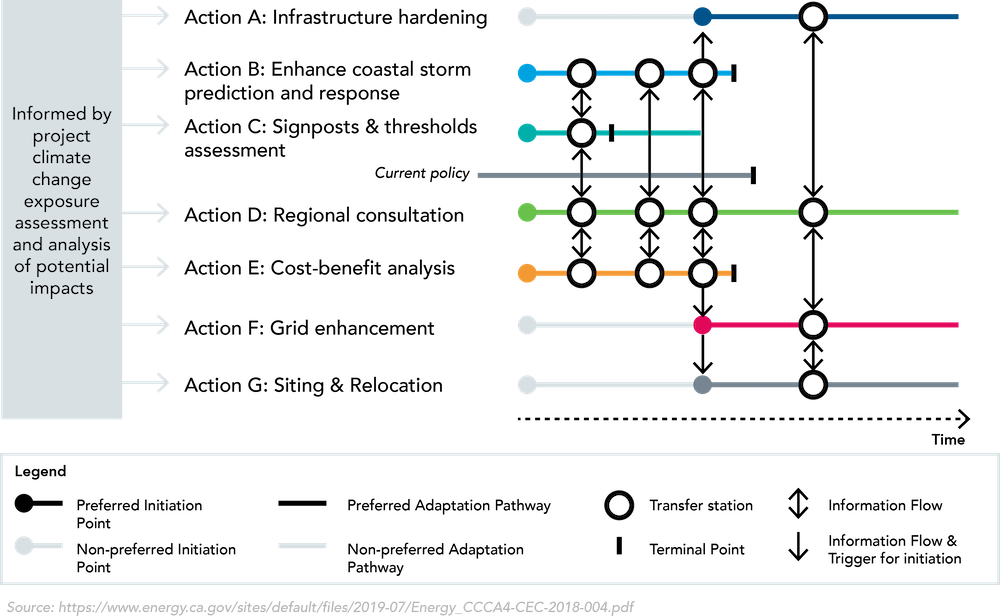
Building utility resilience in a rapidly changing climate
In the last decade, utilities have experienced more extreme weather events than in the past two decades combined. And this has changed the game—it's shown that traditional risk management approaches are no longer sufficient. The old practice of backwards-looking, historical risk management analysis focuses on short-term weather and assumes the future will be like the past.
We now know better.
But utilities often struggle to understand what their risks are and where to get started. How do you quantify your risks, translating climate science into more actionable information for your utility? What investments should you make to mitigate your risks? And, importantly, how do you make decisions today based on a highly uncertain tomorrow? Because doing nothing is no longer an option for utilities.
The cost of inaction may be greater than you realize
Utilities are already experiencing climate change impacts to their bottom line. And the costs of not keeping up and proactively addressing the changing climate are only going to increase.
For Con Edison, one of the largest investor-owned energy companies in the United States, the influence of climate change may require investments between $1.8 billion and $5.2 billion by 2050 to protect its electric, gas, and steam delivery systems and customers from the impacts of climate change.
In San Diego, the regional impacts to San Diego Gas & Electric (SDG&E) customers from a long duration power outage caused by an extreme coastal storm—in combination with potential sea level rise—could be as much as $25 billion, if no mitigation action is taken.
In addition to bottom line impacts, utilities are also feeling pressure from a multitude of other angles:
- Communities throughout the utility service areas—Many communities are beginning to assess their own vulnerabilities to climate risks. In fact, over 80 cities have named Chief Resilience Officers, demonstrating a commitment to addressing climate and weather risks for critical infrastructure services.
- Regulators—States such as New York, California, Hawaii, and Michigan are already asking for filings related to climate change. Other states continue to elevate the issue and are watching these regulators with interest.
- Investors—Investors are increasingly asking questions about management of climate change risks. Many stakeholders are following the Task Force on Climate-Related Financial Disclosures and its physical and transitional risk management guidance. Utilities need to be prepared to answer tough questions about their climate risks and plans for the future—or else.
Between economic and stakeholder pressures, it’s clear that utilities need to take action to mitigate climate risks. But how? Start by understanding the climate science and applying it to your specific utility context.
Translating climate science into actionable information
If the climate science says that global temperatures could increase three or four degrees by the end of the century, what does that mean for your utility? You don’t make decisions based on global temperature. While the information that comes out of academia and modeling centers is a good starting point for utilities, it is not the right endpoint. You need a way to translate climate science into something you can measure and act upon.
Tailoring climate science based on a clear understanding of the vulnerabilities and constraints of a utility system helps construct actionable information. Rather than thinking about average temperature, utilities are often interested in more specific questions such as changes in load due to extreme temperatures. Understanding what variables are used for load forecasting, such as daily maximum and minimum temperatures and humidity, and then solving for those variables for projections of future heat waves builds actionable information customized to utility processes. Using cutting edge climate projections downscaled to the utility territory makes this information actionable for resilience planning at both a local and regional scale.
Of course, even with the best science and models, there will be uncertainty. There’s always uncertainty when it comes to climate predictions. (And if anyone tries to sell you information that promises to predict the climate future of every customer in your territory down to the exact date, overlooking this uncertainty, it’s a red flag and a false path.) But despite this uncertainty, you can’t allow yourself to be paralyzed. Applying the climate science to your utility context—and then taking stock of the entire portfolio of actions available to you—will help you protect your assets and operations.
Use flexible adaptation to account for uncertainty
A robust framework can help utilities make planning decisions and investments in the face of climate uncertainty. While there are a variety of frameworks and approaches available, a flexible adaptation pathway—an ICF approach derived from the academic literature on decision-making under uncertainty— allows you to consider a multitude of actions and adjust to new information and circumstances over time. The pathways include immediate adaptation actions that could be taken today, along with other adaptation actions that could be taken as new information becomes available and certain thresholds are met.

In a pathway diagram—like the example shown here—colored horizontal lines represent courses of action that decision-makers may take along the adaptation pathway. The specific selection and timing of these actions is designed to be flexible over time, based on the inflow of new decision-relevant information such as environmental, regulatory, or technological change. The solid lines show the initial preferred pathway sequencing based on current understanding, whereas the faint lines represent alternative sequencings. White circles represent “triggers,” points at which information produced by a monitoring action (informed by analysis) dictates an adaptation response. Many of these lines reach “terminal points,” indicated by short vertical bars, at which the adaptation is no longer useful given the extent of hazard exposure (e.g., sea level rise exceeding a specific threshold). The termination of the “current policy” line indicates the point at which adaptation measures are needed.
By employing a range of actions to address climate risks at a strategic level—-and combining them in a flexible way—utilities are better equipped to manage risks at tolerable levels, even as the environment changes. A flexible adaptation framework is one tool in a broader toolbox to support utilities taking action.
Leading the way on utility resilience
While the science is sobering and the extreme weather trends continue to rise, some utilities are leading the way toward a more resilient future. We worked with Con Edison to produce a climate change vulnerability study that outlines risks and defines a robust resilience management framework designed to help the utility withstand changes in climate, absorb and recover from outage-inducing events, and advance to a better state. By taking a proactive stance, Con Edison is positioning itself for the future. To learn more about Con Edison’s climate change vulnerability study, and how you might apply some of its methods to your utility context, listen to our webinar.
Knowledge is power. Effective planning for climate resilience requires a detailed understanding of your specific vulnerabilities. Armed with this information, you can begin to take action to protect your assets today—while preparing for an uncertain tomorrow.
